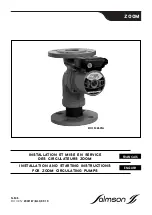
Page 34 / 38
resistant to prevent crushing.
To avoid leakages in the delivery line and get the best performance, ensure to seal the fittings with Teflon.
Remarks:
- All components of the pressure line must be compression-proof.
- All components of the pressure line must be professionally installed
- If the components are not compression-proof or if they are improperly installed, the pressure line could
burst during operation. Risk of injury from liquid spurting out!
4.5.3- Remarks regarding the Delivery and Suction lines
DELIVERY
The choice of pump model must be made keeping in mind the Characteristics of the System.
The combination of the length of the tubing, the diameter of the tubing, the flow rate of the diesel fuel and
the line accessories installed can create back pressure greater than the maximums anticipated such as to
cause the (partial) opening of the pump by-pass with the consequent noticeable reduction of the flow rate
supplied.
In such case, to allow correct functioning of the pump, it is necessary to reduce system resistance, using
shorter tubing and/or of wider diameter and line accessories with less resistance (e.g. an automatic
dispensing nozzle for greater flow rates).
SUCTION
This model is equipped with a self-priming pump with a good suction capacity.
During the start-up phase, with an empty suction tube and the pump wetted with fluid, the electric pump
unit is capable of suctioning the liquid with a maximum difference in height of 2meters. It is important to
point out that the priming time can be as long as one minute and the presence of an automatic dispersing
nozzle on the delivery line prevents the evacuation of air from the installation, and, therefore, prevents
proper priming.
For this reason, it is always advisable to prime the pump without an automatic delivery nozzle, verifying
the proper wetting of the pump.
The installation of a foot valve is recommended to prevent the emptying of the suction tube and to keep
the pump wet. In this way, the pump will subsequently always start up immediately.
When the system is functioning, the pump can work with pressure at the inlet as high as 0.5 bar, beyond
which cavitation phenomena can begin, with a consequent loss of flow rate and increase of system noise.
As we have said up to this point, it is important to guarantee low suction pressure by using short tubing of
a diameter equal to or larger than recommended, reducing curves to a minimum and using suction filters
of wide cross-section and foot valves with the lowest possible resistance.
It is very important to keep the suction filters clean because, once clogged, they increase system
resistance.
The difference in height between the pump and the fluid level must be kept as small as possible and, at
any rate, within the 2 meters anticipated for the priming phase.
If this height is exceeded, it will always be necessary to install a foot valve to allow for the filling of the
suction tube and provide tubing of wider diameter. It is recommended that the pump not be installed at a
difference in height greater than 3 meters.
ATTENTION
In the case that the suction tank is higher than the pump, it is advisable to install an anti-siphon valve to
prevent accidental diesel fuel leaks.
Dimension the installation properly in order to control the back pressures due to water hammering.
4.6- Start-up





































